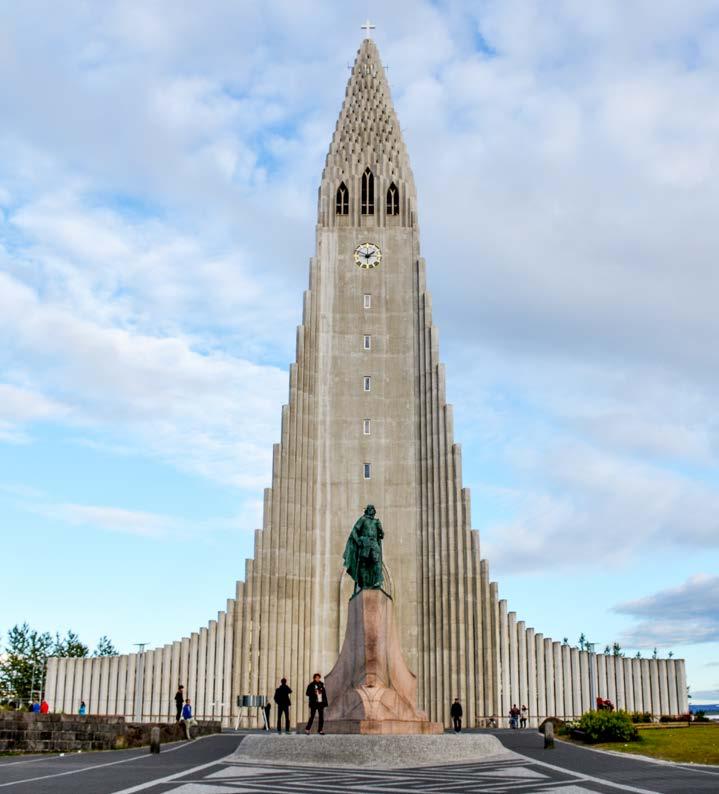
3 minute read
Circumnavigating Iceland Life on and off the Ring Road
By Debbie Olsen
The sparsely populated “land of fire and ice” is a Nordic nirvana filled with dramatic landscapes that entice intrepid travellers to take to the open road.
The words “awe-inspiring” are a little overused when it comes to describing big landscapes, but I couldn’t think of a better phrase as I stood at the edge of Iceland’s Jökulsárlón Glacier Lagoon watching a massive glacier calve into the icy blue water. You feel small and insignificant in the face of such a monumental scene – and that’s the real beauty of it. The sheer abundance of such sites in Iceland makes it one of the world’s best road trip destinations.
My husband, Greg, and I had been talking about visiting Iceland but when my brother, Justin, suggested we all go together, that sealed the deal. Meeting in Iceland and doing a road trip together seemed like the perfect opportunity to reconnect with my younger sibling.

HALLGRÍMSKIRKJA LUTHERAN CHURCH REYKJAVIK
We figured two weeks would give us enough time to make the 1,330-kilometre road trip around the entire island. Driving in Iceland is easy. Roads are well-maintained and Icelanders drive on the right side of the road and pass on the left. Fuel, however, was expensive.
The sparsely populated Westfjords was one of our first stops. We loved the wild beauty of the area and, for us, the two biggest highlights were Dynjandi Waterfall and the Látrabjarg cliffs. We drove a long way on a gravel road to reach Dynjandi. Also known as Fjallfoss, the waterfall is nearly 100 metres high and about 60 metres wide at the bottom. It is perched high on a cliff face and there are other waterfalls below it. A rocky hiking path passes the other waterfalls and leads to the base of Dynjandi.

FJAÐRÁRGLJÚFUR CANYON
The Látrabjarg cliffs on the westernmost point of Iceland are the largest seabird cliffs in Europe. These spectacular cliffs are 441 metres high and 14 kilometres long, but the best thing about them is the millions of seabirds that nest there. It’s a photographer’s paradise. We spent hours photographing puffins that were within an arm’s reach of us.
After the Westfjords, we made our way to the northern region of the country, stopping at a local farm to ride Icelandic horses and play with some Icelandic sheepdog pups before continuing on. We stopped the car often to go exploring and take pictures. There was plenty of time to chat and reconnect along the way.

REYNISFJARA BEACH BASALT COLUMNS ©DEBBIE OLSEN
Our favourite stops in the north were Hverarönd geothermal area, Goðafoss Waterfall and Mývatn Nature Baths. The geothermal area is fascinating with its bubbling hot pots and hissing steam vents. Goðafoss means “waterfall of the Gods” and the 30-metre-wide waterfall is one of the most spectacular in the country. After our busy explorations, we deserved a soak in the Myvatn Nature Baths, the quieter “blue lagoon of the north.”
We eventually made our way to southern Iceland and the popular tourist route, the Golden Circle, known for its many waterfalls, geysers and glaciers. Þingvellir (Thingvellir) National Park is an unexpected highlight of this region. This UNESCO Heritage Site has a fascinating history and its location at the meeting point of the North American and Eurasian tectonic plates makes it one of the few places in the world where you can walk in the rift between two continents.

JUSTIN AND DEBBIE AT FJAÐRÁRGLJÚFUR CANYON
Our trip was made complete with a few days in Reykjavik. The capital has fantastically photographable architecture and great restaurants, but the highlight for us turned out to be the cemetery. As the three of us stood looking over the cemetery wall, a friendly local who had been visiting his family’s graves offered us a free private tour, telling us about the country’s history, showing us graves of famous Icelanders. He also talked about families, family names and Icelandic culture. After a week spent reconnecting with family, our impromptu tour with this generous stranger was the perfect way to end our exploration of Iceland.










